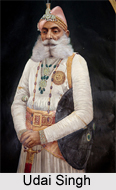 Maharana Udai Singh, the 53rd ruler of the Mewar dynasty was the founder of the city of Udaipur in the present day Rajasthan state of India. Maharana Udai Singh was born in August 4, 1522 and was the fourth and posthumous son of Maharana Sangram Singh and Rani Karmavati, a princess of Bundi. Udai Singh was born in Chittor, after the death of his father, Maharana Sangram Singh and his eldest surviving son, Maharana Ratan Singh, succeeded him. Ratan Singh was also murdered in 1531. His brother Maharana Vikramaditya Singh succeeded him. During his reign, when the Sultan of Gujarat Bahadur Shah dismissed Chittor in 1534, Udai Singh was sent to Bundi for safety measures. In 1537, Banbir killed Vikramaditya and usurped the throne. He also tried to kill Udai Singh, but Udai`s nurse Panna Dhai sacrificed her own son to save the king from his uncle Banbir and took him away to Kumbhalgarh. He lived in secret in Kumbhalgarh for two years as a nephew of the governor Asha Shah. In 1540, the nobles of Mewar crowned him in Kumbhalgarh. His eldest son Maharana Pratap was born in the same year and he had twenty-five sons. Amongst his other sons, Sakta (Shakti), Jagmal and Viramdeo are well known for their bravery in Indian History.
Maharana Udai Singh, the 53rd ruler of the Mewar dynasty was the founder of the city of Udaipur in the present day Rajasthan state of India. Maharana Udai Singh was born in August 4, 1522 and was the fourth and posthumous son of Maharana Sangram Singh and Rani Karmavati, a princess of Bundi. Udai Singh was born in Chittor, after the death of his father, Maharana Sangram Singh and his eldest surviving son, Maharana Ratan Singh, succeeded him. Ratan Singh was also murdered in 1531. His brother Maharana Vikramaditya Singh succeeded him. During his reign, when the Sultan of Gujarat Bahadur Shah dismissed Chittor in 1534, Udai Singh was sent to Bundi for safety measures. In 1537, Banbir killed Vikramaditya and usurped the throne. He also tried to kill Udai Singh, but Udai`s nurse Panna Dhai sacrificed her own son to save the king from his uncle Banbir and took him away to Kumbhalgarh. He lived in secret in Kumbhalgarh for two years as a nephew of the governor Asha Shah. In 1540, the nobles of Mewar crowned him in Kumbhalgarh. His eldest son Maharana Pratap was born in the same year and he had twenty-five sons. Amongst his other sons, Sakta (Shakti), Jagmal and Viramdeo are well known for their bravery in Indian History.
After defeating Banbir at Mavli, Maharana Udai Singh returned to Chittor and in 1559, his grandson Maharana Amar Singh was born. In the same year, he founded the city of Udaipur. In 1562, Maharana Udai Singh gave refuge to Baz Bahadur of Malwa. Using this as a reason, Akbar attacked Mewar in October1567. Maharana Udai Singh retired to Gogunda (which later became his temporary capital) after leaving Chittor in the hands of his loyal chieftains. Akbar captured Chittor after a long siege in February, 1568.
Maharana Udai Singh later shifted his capital to Udaipur. However, he died in 1572 in Gogunda and before his death, Maharana Udai Singh nominated his favorite son Jagmal as his successor. But after his death, the nobles of Mewar prevented Jagmal from succeeding and thus placed Maharana Pratap Singh on the throne.



















